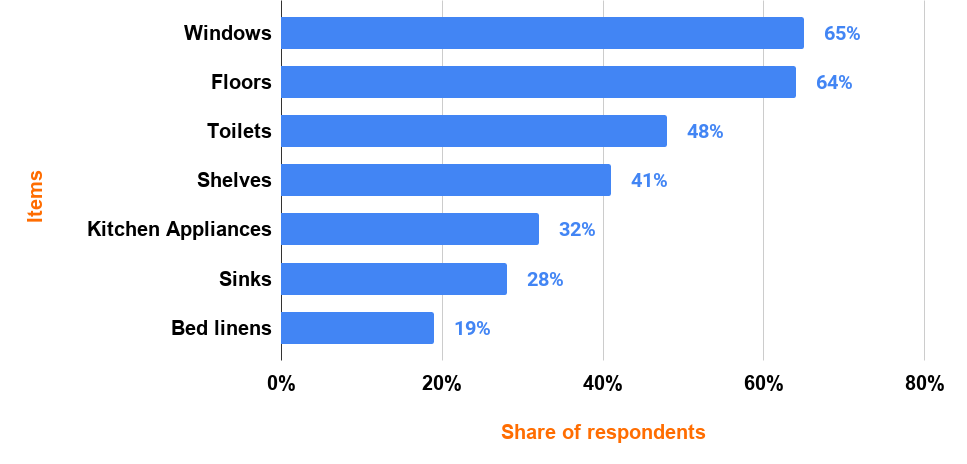- As opposed to what many people of stainless steel sinks, they can also get stained too. Stainless sinks can be affected by different stains and we’ll be looking at each of those stains in this article.
- We’ll also be discussing the steps on how to remove chemical stains from your stainless steel sink to leave it sparkling clean again.
The truth is that stainless steel material remains one of the most ideal materials for home purposes. This is why in the house, you see ‘stainless steel this’, ‘stainless steel that’. The importance of stainless steel materials in the house cannot be overemphasized. Asides from being able to absorb stains, these materials are built to resist rust due to the presence of chromium oxide. As a result, it shines brighter and lasts longer than the other types of steel. If you’ve had to deal with the other metal types before, you’d have realized they are more exposed to corrosion. This keeps stainless steel a country mile ahead of the other metals and again, thanks to the presence of chromium oxide.
The good thing about chromium oxide is that it’ll keep forming again as time goes on. This makes it the strongest element in the formation of stainless steel as it keeps it protected against rust and corrosion always. However, it is very possible that stains start creeping in at some point, especially when your stainless steel sink comes in contact with a very powerful chemical. The best thing you can do in this case is to make sure you tackle the stain(s) immediately and not hesitate for much longer than you should. Chemical stains, when not handled properly, can completely change the look of your stainless steel sink. When that happens, it will change the feel in your space (wherever the sink is located) and that’s when you’ll start considering getting it replaced. For this not to happen, you need to make sure chemical stains are tackled as soon as possible.
Before we get into the types of stains that can affect your stainless steel sink and how you can deal with the ones caused by chemicals, let’s take a quick look at the pros and cons of stainless steel sinks.
PROS AND CONS OF STAINLESS STEEL SINKS
PROS
THEY ARE DURABLE
If there’s anything anyone can vouch for the most about stainless steel sinks, it is that they are highly durable. As a result of how stainless steel sinks are made, it’s hard for them to get scratches. Having a stainless steel sink in your space leaves you with extra peace of mind because you won’t have to worry about replacing it except something really extraordinary happens. The surface of a stainless steel sink is non-porous, thereby making it very easy to clean.
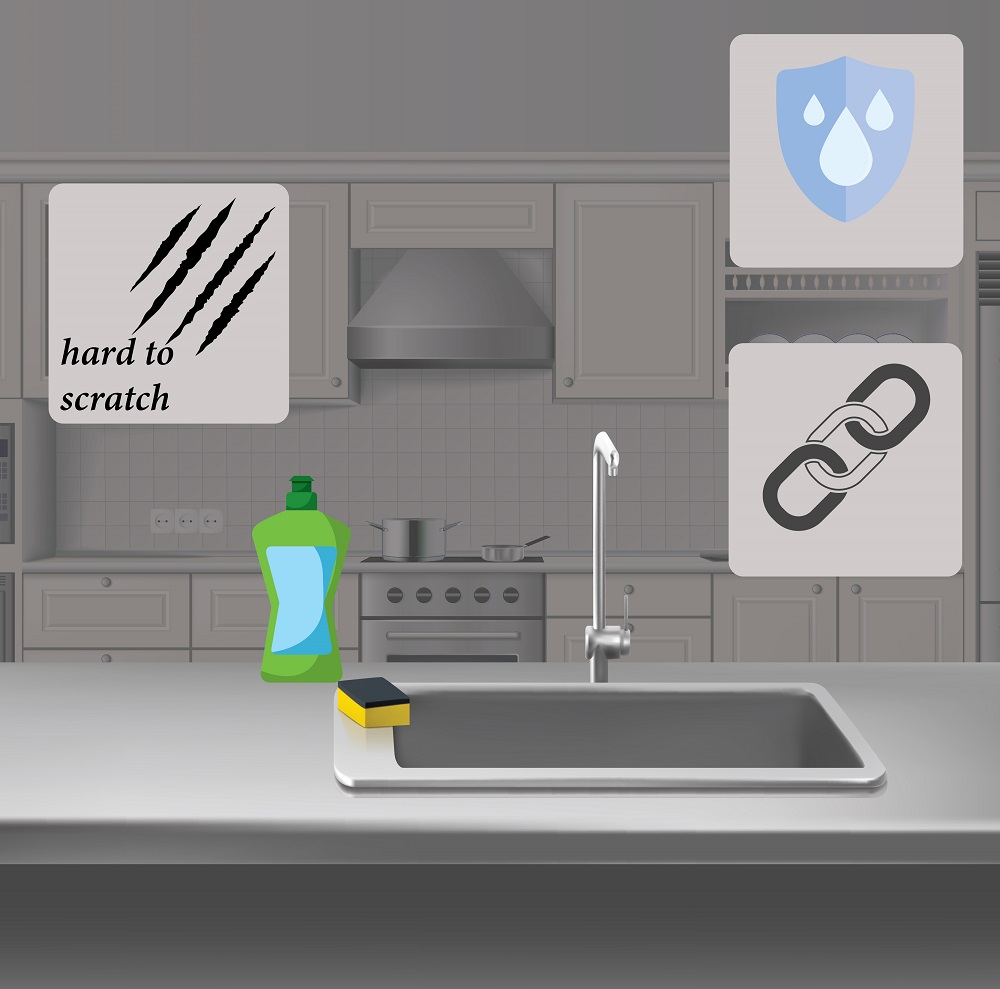
STAINLESS STEEL SINKS COMPLEMENT OTHER APPLIANCES WELL
If you’re looking for a material that offers different varieties of colors, then stainless steel might not be ideal for you. Despite being limited in that area, a stainless steel sink in your space will perfectly complement the other appliances you have in there; stainless steel or not. The good thing is that most appliances coming through these days are made of stainless steel, so that makes it all perfect. This is why they are the most-used sinks in the market.
Stainless steel sinks perfectly compliment some of the commercial sink faucets you have in your kitchen space.
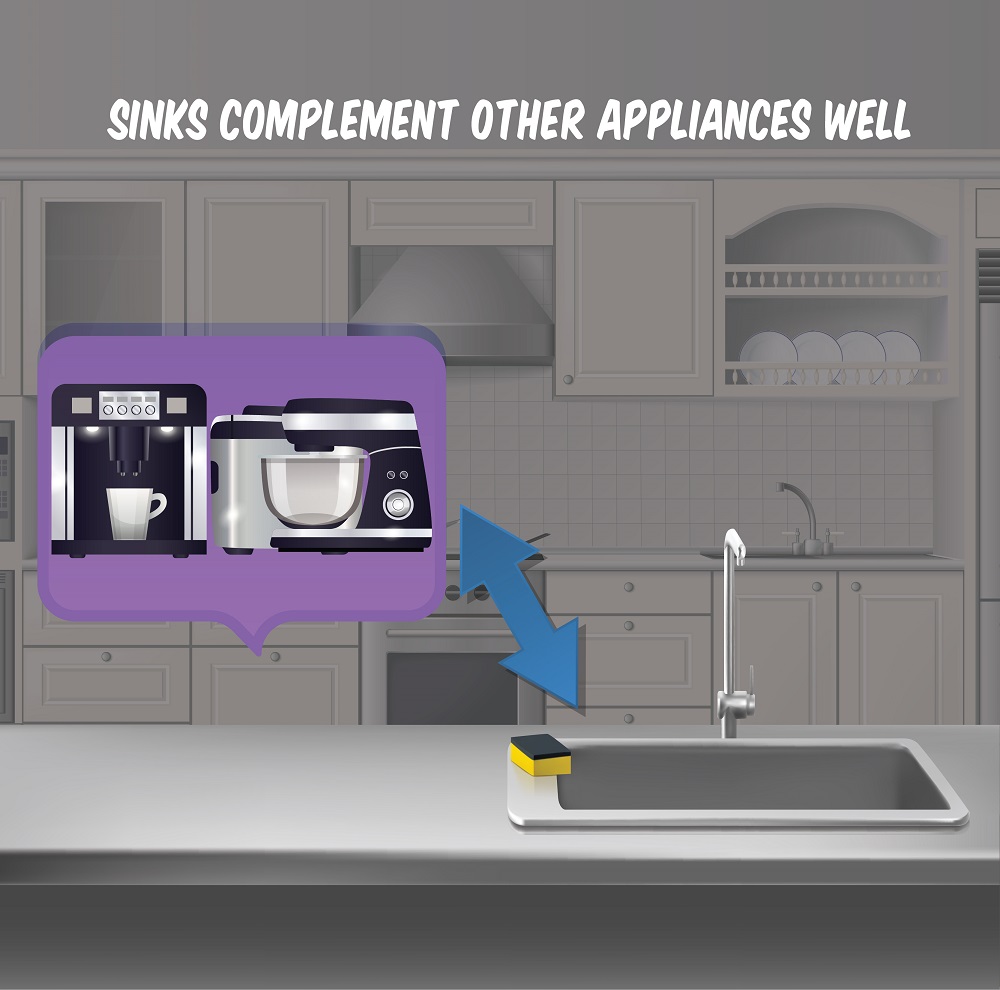
CONS
LIMITED OPTIONS
We mentioned earlier that with stainless steel sinks, there are some limitations as far as colors and finishes are concerned. No matter how good a stainless steel sink is; no matter how perfectly it complements other kitchen appliances, it will always be in one form and that’s stainless steel. People who love to have several options available to them when making a purchase don’t have much of a choice now because stainless steel sinks only come in one color. This is not entirely a bad thing as it makes up for this with the other amazing perks that come with it.
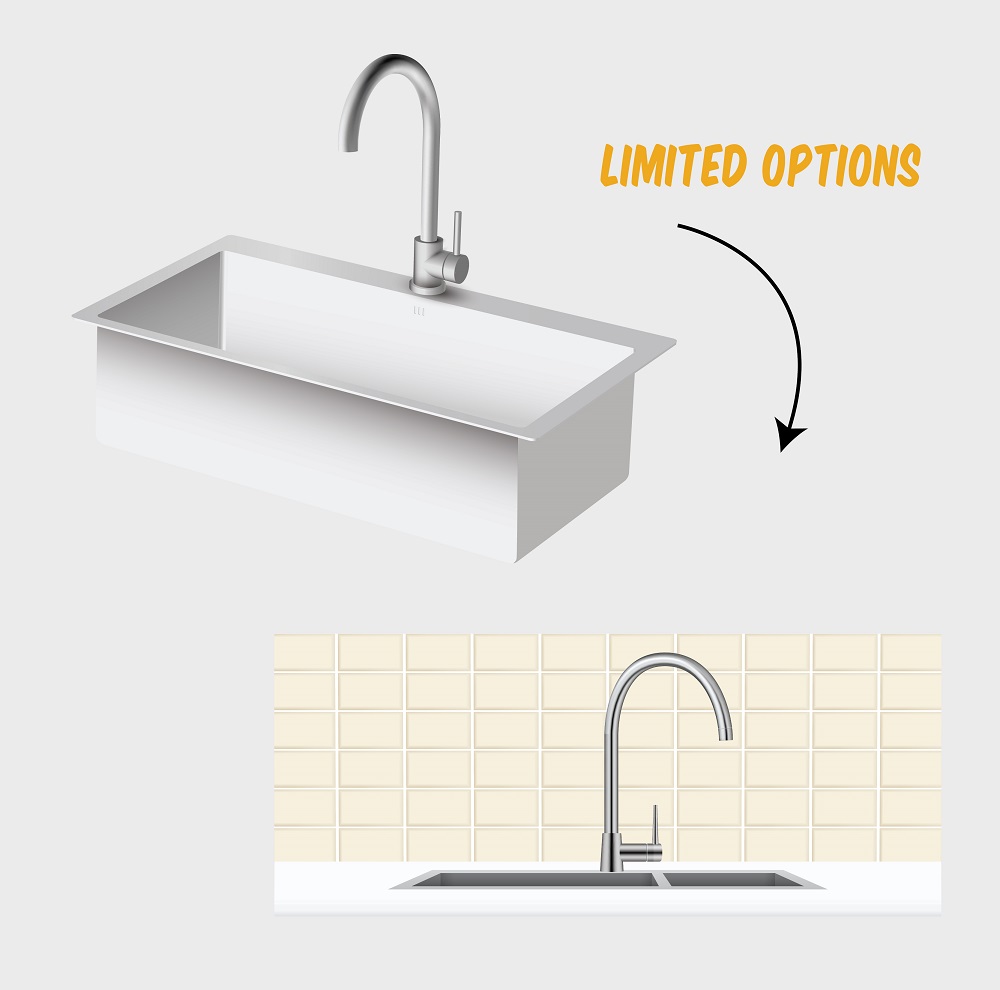
INITIAL COST OF PURCHASE IS HIGH
When it comes to interior materials, stainless steel is only behind granite in terms of the cost of purchase. Although when you put long-term purpose into consideration, you’ll realize it is worth the initial stress. A lot of people still find a stainless steel sink worth the money and so do we. We believe you’ll get the value for every penny spent to get it in the first place and that’s one of the most amazing things about stainless steel sinks.
Even with these drawbacks, we still believe stainless steel sinks are still the best and are worth every dollar spent on them.

DIFFERENT STAINLESS STEEL STAINS
IRON STAINS
Iron stains occur when there’s a scratch on the surface of the stainless steel sink and as a result, there are pieces of iron on it. These fragments of iron will definitely cause the stainless steel to begin to lose its natural chromium concentration. Chromium oxide is naturally responsible for the sink’s protection against rust and corrosion. When the chromium concentration eventually falls below 10%, your stainless steel sink will begin to rust. The best remedy to this stain is to remove the fragments of iron that caused the rust in the first place as well as the rust. Once you do this, the chromium oxide will begin to build up again until the layer forms fully to prevent the sink from rust.
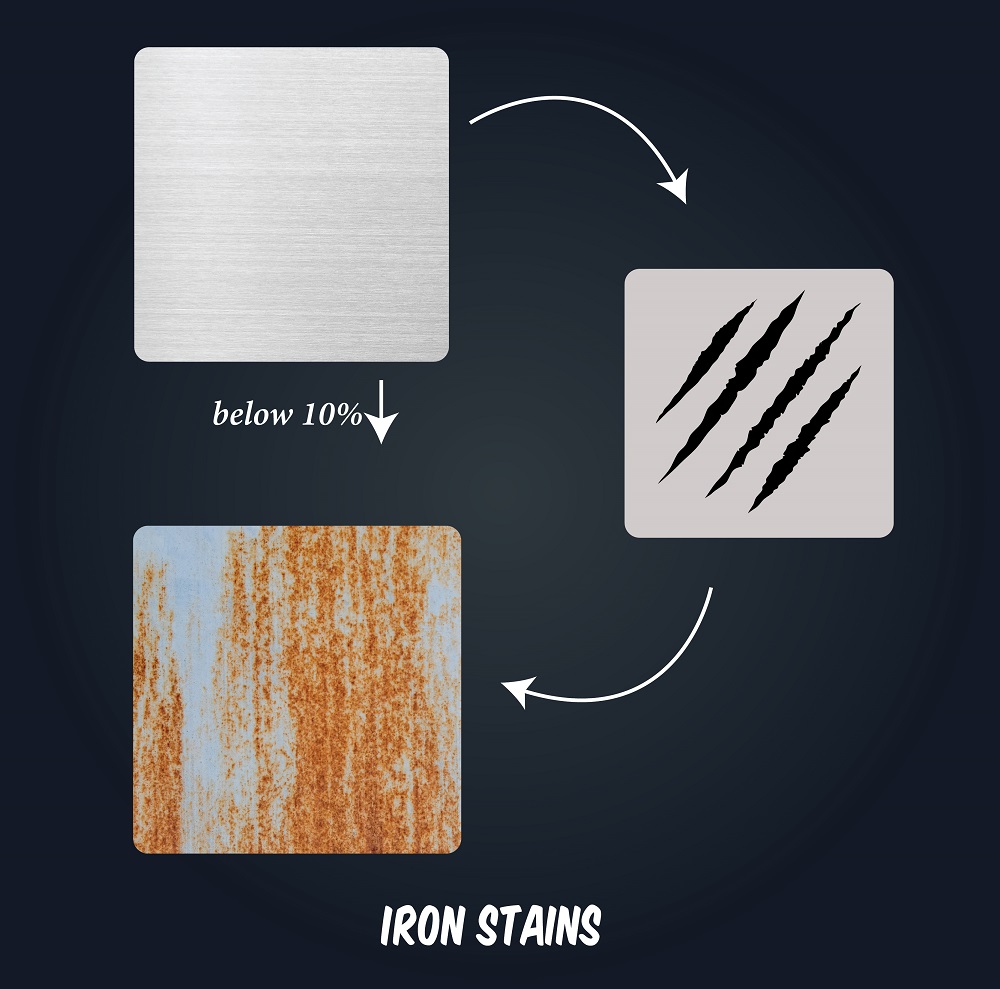
CHLORIDE STAINS
These stains are classified as perhaps the worst stains that your stainless steel sink can take on because they cannot be corrected as they look to make a lasting impact. The good thing about this type of stain is that you have more than enough time to prevent it because one or two events cannot have any effect. These stains are mostly caused by salt or bleach and these stains are only visible when you’ve left these things to stay on your sink for a longer period.
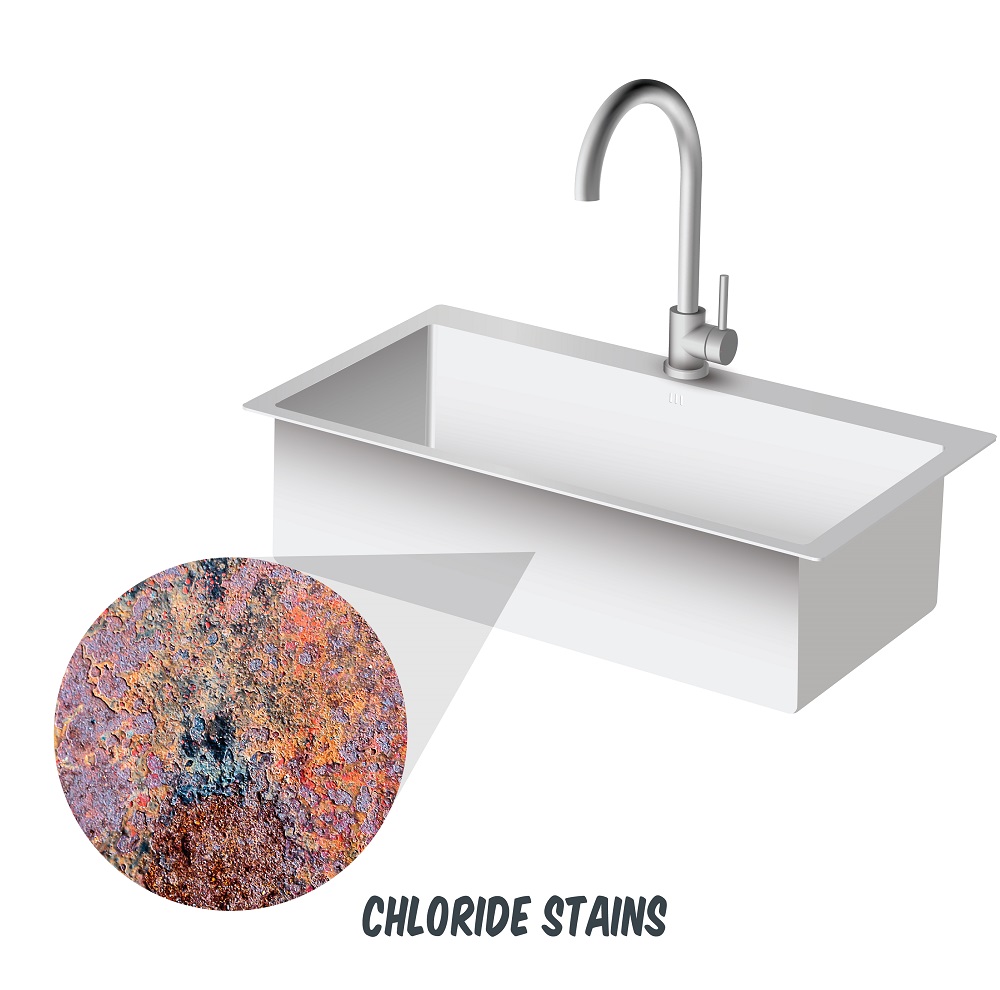
ACID STAINS
Acid stains are one of the chemical stains that can greatly affect your stainless steel sink. If you have any liquid whose pH level has dropped below 1.0, it means that the acid in such liquid has grown strong and as a result of that, there will be stains on your stainless steel sink. Some of the household items that can cause these acid stains are acid-base cleaners, vinegar, polishes, juices, and many more. Since these are common household items, the chances of having one of them around your stainless steel sink are very high. If you have a discolored stainless steel sink, it’s likely to be caused by acid-base household items. The good thing is that these stains can be cleaned off; thanks to some of the methods we are going to be discussing later in this article.
HOW TO REMOVE CHEMICAL STAINS FROM STAINLESS STEEL SINK
Even tough stains like chemical stains can be taken off your stainless steel with inexpensive methods. Before you begin, make sure you make safety a priority as you’ll be needing hand gloves and a face mask to make sure you don’t come in contact with any of these chemicals you’re trying to clean off.
This is a chart that shows the dirtiest items in the home in the United States in 2020. As published by Statista, the chart shows windows were more prone to dirt in different homes in the United States.
Let’s take a quick look at the different DIY methods you can apply to make sure chemical stains don’t ruin your pretty stainless steel sink;
DISH SOAP AND BAKING SODA
Baking soda is one of the most highly effective natural cleansers and that’s why you will always see it on any list as far as cleaning is concerned. A discolored stainless steel sink might be a result of chemical stains and one way to get that cleaned off is to combine your liquid dishwasher with baking soda. To get this done, you’ll also need a paper towel and a bowl (this is to mix the dish soap and baking soda) as well as an old toothbrush.
DIRECTION
STEP 1: Prepare your bowl and ensure it’s clean. Mix the dish soap and baking soda into this bowl.
STEP 2: Apply the mixture of baking soda and dish soap on the toothbrush and rub it on the affected area of your stainless steel gently.
STEP 3: After a couple of minutes, rinse the paste off the sink with warm water and wipe it clean using your paper towel.
For this method to be as effective as it looks, you need to make sure all these steps are followed as they’ve been outlined.
VINEGAR
Vinegar is also a very effective natural cleanser like baking soda but it’s meant for stronger chemical stains. You’ll need to be careful when using vinegar because it works most effectively on tougher stains.
DIRECTION
STEP 1: Add the right amount of vinegar into a spray bottle and spray it on the affected area of your stainless steel sink.
STEP 2: For the vinegar to work effectively, you’ll have to wait for some minutes. If you wait for 10 minutes, you’ll have given the vinegar enough time to put the stains out completely.
STEP 3: Now, this is the part where your towel paper comes in. Gently use this towel to rub the area where the vinegar was initially applied. The stain will be gone in no time!
AMMONIA
The only time you can turn to ammonia is when the stain is so tough that baking soda can’t get it out. Ammonia is a powerful cleanser just like vinegar and it works super effectively on tough stains too. To use this method, you’ll need a spray bottle as well as a very clean towel.
DIRECTION
STEP 1: Mix the right amount of water and ammonia in a bowl and make sure the mixture is not too thick.
STEP 2: Add this mixture to the stained area and leave it for at least 15 minutes so it can work effectively.
STEP 3: Use a clean towel to wipe off the paste from the stained area and proceed to use another wet towel to clean the whole thing off completely.
Frequently Asked Questions
1. Can acetone damage stainless steel?
Not if it’s used properly. Stainless steel is stronger than most people think and the surprising thing is that elements like toluene, kerosene, and the one in question, acetone, are all safe to be used to clean stainless steel as long as they’re used in the right quantities or as recommended.
2. Does vinegar damage stainless steel?
Whenever you use vinegar to clean stains off your stainless steel sink, you should make sure that it is properly wiped off the surface. If you don’t properly wipe the leftover residue off, this can cause the chromium oxide in the stainless steel to start wearing off and that’s not good at all. Vinegar is a natural cleanser but you need to make sure you use it the right way to avoid negative results.
Conclusion
It’s all glaring now that even stainless steel is not immune to stains. The good thing is that tough stains can be taken off your stainless steel sink and all the methods we’ve highlighted in this article are very effective. However, you need to make sure safety comes first when trying these methods. That means protecting your hands and your face as well as not leaving these cleansers on the surface of your stainless steel sink for too long to avoid further damages.
01 HOUR 15 MINUTES
ESTIMATED TIME DESIGNING AND UPLOADING THIS ARTICLE
09 HOURS 42 MINUTES
ESTIMATED TIME RESEARCHING AND WRITING THIS ARTICLE
You Might Also Like

